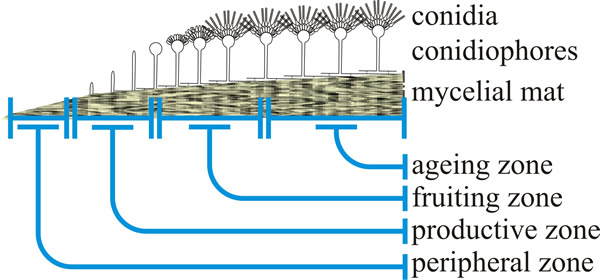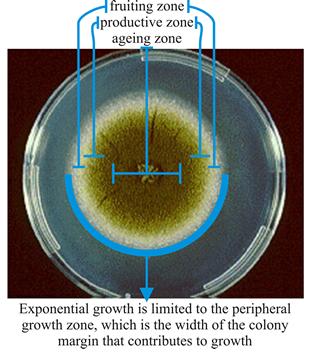4.6 Morphological differentiation of fungal colonies
Changes in the medium of this sort mean that there are consequential changes in the conditions experienced by hyphae at different positions in the colony and this results in hyphal differentiation. Hyphal differentiation is very evident in the morphological differentiation of fungal colonies (Figs 12 & 13); as nutrients become depleted beneath the centre of the colony and metabolic products accumulate, spore production is often initiated.
 |
|---|
| Fig 12. Morphological differentiation of colonies of Aspergillus shown in a diagrammatic radial section. |
 |
| Fig. 13. Morphological differentiation of colonies of Aspergillus shown in a photograph with the peripheral growth zone and other differentiated zones indicated. |
Therefore, different parts of the colony are at different physiological ages, with the youngest actively extending hyphae at the edge of the fungal colony and the oldest, non-extending, sporulating mycelium at the centre. This has been demonstrated by estimating variation in growth rate within a mature colony of Aspergillus niger by measuring the specific rate of 32P uptake in different zones of the colony (Table 2).
| Table 2. Physiological differentiation in Aspergillus niger revealed by variation in growth rate within a mature colony measured by its ability to take up radioactive phosphate. | ||
Uptake of 32P by a mature
colony of Aspergillus niger |
||
| Zone of colony (as shown in Fig. 12) | Width of region (mm) |
Specific rate of
32P uptake as a percentage of uptake in the peripheral zone |
| Peripheral (extending) | 1.5 |
100 |
| Productive | 2.0 |
31 |
| Fruiting | 4.5 |
6 |
| Aged | 3.5 |
3 |
Updated July, 2019
